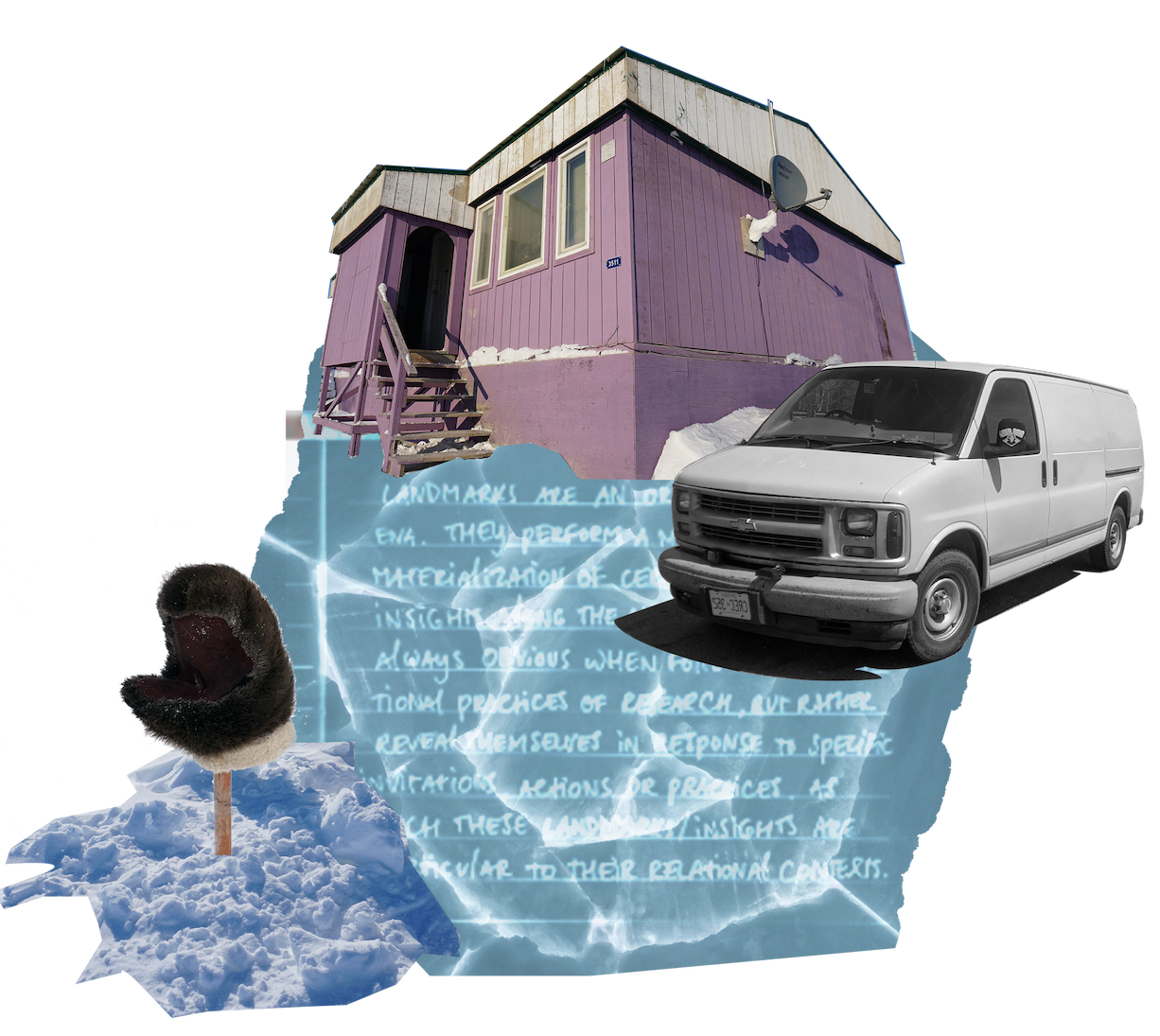Knowledge as Movement and Dwelling: Difference between revisions
No edit summary |
No edit summary |
||
| (20 intermediate revisions by the same user not shown) | |||
| Line 1: | Line 1: | ||
[[File:Landmark.png|thumb]] | [[File:Landmark small.png|thumb]] | ||
Landmarks are defining features in the land that traditionally play an important role in Inuit topographical understandings of their land and its resources. They are important orienting features to keep one's bearing while travelling and to determine where one is located at any given moment<ref>Aporta, C. (2004). Routes, trails and tracks: Trail breaking among the Inuit of Igloolik. Études/Inuit/Studies, 28(2), 9-38.</ref>. | Landmarks are defining features in the land that traditionally play an important role in Inuit topographical understandings of their land and its resources. They are important orienting features to keep one's bearing while travelling and to determine where one is located at any given moment<ref>Aporta, C. (2004). Routes, trails and tracks: Trail breaking among the Inuit of Igloolik. Études/Inuit/Studies, 28(2), 9-38.</ref>. | ||
| Line 5: | Line 5: | ||
As a figure in this Knowledge-Land-Scape, "Landmarks" perform the materialization of certain findings and emergent insights along the way. | As a figure in this Knowledge-Land-Scape, "Landmarks" perform the materialization of certain findings and emergent insights along the way. | ||
This particular one, marks my understanding of how some knowledge only comes into being through movement- or | This particular one, marks my understanding of how some knowledge only comes into being through movement- or ''as'' movement. | ||
My continous moving in-between countries, territories, timezones, languages, cultures, relationships allowed for intra-relational thinking across entities and events, rather than inter-relational thinking merely between entities and events. It started to create tentative openings in which my campervan Butter, the covid-virus, hot tarmac, the seasons, vaccines, all became agents in the production of space, time, meaning and matter within my research, instead of the other way around. Slowly, I started to understand that any knowledge generated within this liminal space, requires attunement to the agential web of all the entities and events you move through and alongside with<ref>Braidotti, R. (2006 p.271). Transpositions: On nomadic ethics. Polity.</ref>. Even time and space itself is produced by the intra-relational dynamics within such a web. | |||
<div class="next_choice"> | <div class="next_choice"> | ||
'''"Return"''' to Cut 1: Voices of Thunder, if you were seeking to collaborate with the Gjoa Haven HTA - but you got redirected by the Covid-19 pandemic. | |||
Or, | |||
<span class="return to cut 1 link" data-page-title="Multiple Voices" data-section-id="0" data-encounter-type="return">[[Multiple Voices|Cut 1: | '''"Return to Cut 3"''', to continue tracing other parts of the BearWatch project that I got involved with.</div> | ||
<small><references /></small> | |||
<span class="return to-cut-1 link" data-page-title="Multiple Voices" data-section-id="0" data-encounter-type="return">[[Multiple Voices|Return to Cut 1]]</span> | |||
<span class="return to-cut-3 link" data-page-title="Wayfaring_the_BW_project" data-section-id="3" data-encounter-type="return">[[Wayfaring the BW project#Spring Coral Harbour 2020|Return to Cut 3: Spring Coral Harbour 2020]]</span> | |||
Latest revision as of 12:22, 18 July 2025

Landmarks are defining features in the land that traditionally play an important role in Inuit topographical understandings of their land and its resources. They are important orienting features to keep one's bearing while travelling and to determine where one is located at any given moment[1].
As a figure in this Knowledge-Land-Scape, "Landmarks" perform the materialization of certain findings and emergent insights along the way.
This particular one, marks my understanding of how some knowledge only comes into being through movement- or as movement.
My continous moving in-between countries, territories, timezones, languages, cultures, relationships allowed for intra-relational thinking across entities and events, rather than inter-relational thinking merely between entities and events. It started to create tentative openings in which my campervan Butter, the covid-virus, hot tarmac, the seasons, vaccines, all became agents in the production of space, time, meaning and matter within my research, instead of the other way around. Slowly, I started to understand that any knowledge generated within this liminal space, requires attunement to the agential web of all the entities and events you move through and alongside with[2]. Even time and space itself is produced by the intra-relational dynamics within such a web.
"Return" to Cut 1: Voices of Thunder, if you were seeking to collaborate with the Gjoa Haven HTA - but you got redirected by the Covid-19 pandemic.
Or,
